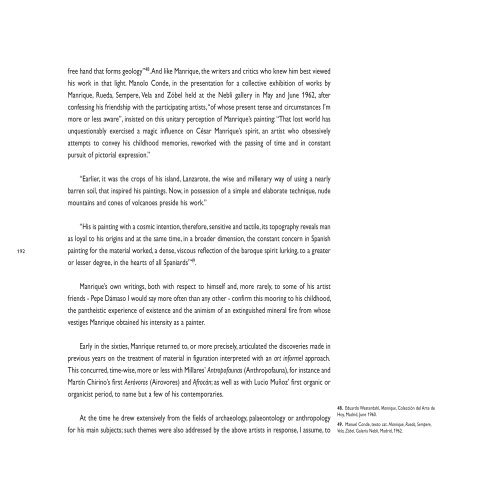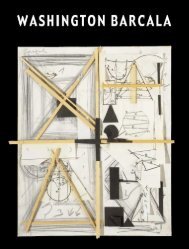VERSIÓN INGLESA ENGLISH VERSION - Fundación César Manrique
VERSIÓN INGLESA ENGLISH VERSION - Fundación César Manrique
VERSIÓN INGLESA ENGLISH VERSION - Fundación César Manrique
Create successful ePaper yourself
Turn your PDF publications into a flip-book with our unique Google optimized e-Paper software.
192<br />
free hand that forms geology” 48 . And like <strong>Manrique</strong>, the writers and critics who knew him best viewed<br />
his work in that light. Manolo Conde, in the presentation for a collective exhibition of works by<br />
<strong>Manrique</strong>, Rueda, Sempere, Vela and Zóbel held at the Neblí gallery in May and June 1962, after<br />
confessing his friendship with the participating artists, “of whose present tense and circumstances I’m<br />
more or less aware”, insisted on this unitary perception of <strong>Manrique</strong>’s painting: “That lost world has<br />
unquestionably exercised a magic influence on <strong>César</strong> <strong>Manrique</strong>’s spirit, an artist who obsessively<br />
attempts to convey his childhood memories, reworked with the passing of time and in constant<br />
pursuit of pictorial expression.”<br />
“Earlier, it was the crops of his island, Lanzarote, the wise and millenary way of using a nearly<br />
barren soil, that inspired his paintings. Now, in possession of a simple and elaborate technique, nude<br />
mountains and cones of volcanoes preside his work.”<br />
“His is painting with a cosmic intention, therefore, sensitive and tactile, its topography reveals man<br />
as loyal to his origins and at the same time, in a broader dimension, the constant concern in Spanish<br />
painting for the material worked, a dense, viscous reflection of the baroque spirit lurking, to a greater<br />
or lesser degree, in the hearts of all Spaniards” 49 .<br />
<strong>Manrique</strong>’s own writings, both with respect to himself and, more rarely, to some of his artist<br />
friends - Pepe Dámaso I would say more often than any other - confirm this mooring to his childhood,<br />
the pantheistic experience of existence and the animism of an extinguished mineral fire from whose<br />
vestiges <strong>Manrique</strong> obtained his intensity as a painter.<br />
Early in the sixties, <strong>Manrique</strong> returned to, or more precisely, articulated the discoveries made in<br />
previous years on the treatment of material in figuration interpreted with an art informel approach.<br />
This concurred, time-wise, more or less with Millares’ Antropofaunas (Anthropofauna), for instance and<br />
Martín Chirino’s first Aeróvoros (Airovores) and Afrocán; as well as with Lucio Muñoz’ first organic or<br />
organicist period, to name but a few of his contemporaries.<br />
At the time he drew extensively from the fields of archaeology, palaeontology or anthropology<br />
for his main subjects; such themes were also addressed by the above artists in response, I assume, to<br />
48. Eduardo Westerdahl, <strong>Manrique</strong>, Colección del Arte de<br />
Hoy, Madrid, June 1960.<br />
49. Manuel Conde, texto cat. <strong>Manrique</strong>, Rueda, Sempere,<br />
Vela, Zóbel, Galería Neblí, Madrid, 1962.
















![Becas y premios de la Fundación César Manrique [1997-2006]](https://img.yumpu.com/20766851/1/184x260/becas-y-premios-de-la-fundacion-cesar-manrique-1997-2006.jpg?quality=85)
